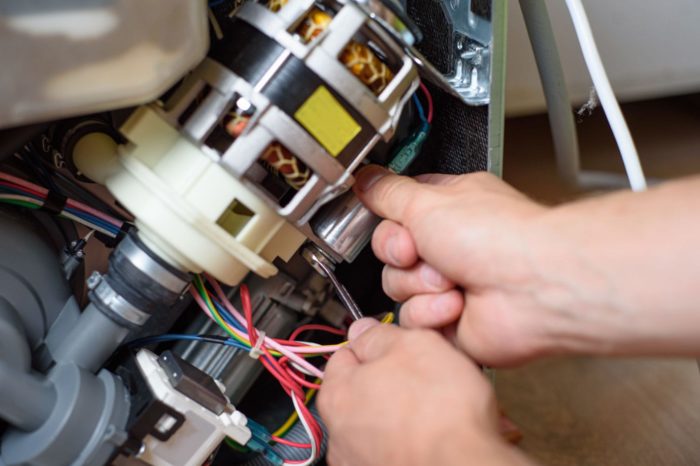Right off the bat, we are going to assume that you’ve checked that the power cord is plugged in, that the breaker or fuse is working properly, and that you’ve familiarized yourself with the specific make and model. If you haven’t done those things, well, do them!
Most of the time the issue will be something simple like a blown fuse, but if that’s not the case you’ll want to inspect the electrical (or chemical) and mechanical components for issues.
Possible electrical or chemical issues
- Thermal fuse. This prevents the dryer from overheating, and if blown, a clogged dryer vent or electrical surge is likely the culprit. Inspect the vent for blockage and clean if necessary to prevent future issues. There’s not much that can be done about future power surges other than using a surge protector if the dryer’s power cable will fit, although most dryers use a special 30 amp plug and outlet. The fuse is normally located near the dryer’s heating element and is simple to replace. Use a voltage tester to see if it’s functioning properly.
- Start and door switch. Both are easy to check, but somewhat more difficult to fix and essential for a working dryer. If the dryer door shuts with a click, the door switch is ok. If when you try to start the dryer, it hums, but doesn’t turn, the start switch is ok. If not, it will need to be replaced.
- Main control board, belt switch, and timer. Unfortunately, there is no easy way to check if these are functioning other than using a voltage tester, but if everything else seems to be working one of these components may be faulty and need replacing.
- Pilot light. On a gas dryer, if the drum turns but there is no heat, the pilot light may have been extinguished. Relight it to fix the problem.

Possible mechanical issues
- Lint filter. A common solution if the dryer is working in all observable ways but not drying clothes. A clogged lint filter can prevent air from properly circulating in the drum, and are often neglected by owners. Regular cleaning will prevent issues.
- Drive belt. If everything else on the machine is working but the drum doesn’t turn, there may be an issue with the drive belt. Similar to a car engine, the drive belt is attached to the drive motor and can break or become entangled. For either issue, replace the drive belt.
- Drive motor. If all other things appear intact and functional, but the dryer drum still won’t spin, the drive motor is likely faulty and will need to be replaced.
- Noise. If the dryer is making an unexpected noise there is most likely a foreign object stuck in the drum area. Use the rear access panel to inspect for any loose items around the drum. If the dryer is shaking or rocking while operating it will need to be leveled, either by using the installed adjustable feet or using other objects such as planks of wood.
Most common dryer issues can be traced to one or more of the above issues and are generally easy to repair. Learning to repair your own appliance can save you money and be personally rewarding, but what if you want to learn how to repair and maintain more complex issues and appliances?
LEARN HOW TO REPAIR APPLIANCES WITH UNCLE HARRY
You can learn how to professionally repair appliances with the help of Uncle Harry. If you’re interested in becoming an appliance repair technician or learning how to run a successful appliance repair business, our repair school has a heavy focus on business ownership. Our Platinum Program 2021 features over 200+ videos that can walk you through appliance repairs in real time with real customers. By choosing Uncle Harry’s repair school, you can rest assured knowing you’ll always have a great support network behind you to assist you when you need it. Call today or contact us to learn more and get enrolled!
